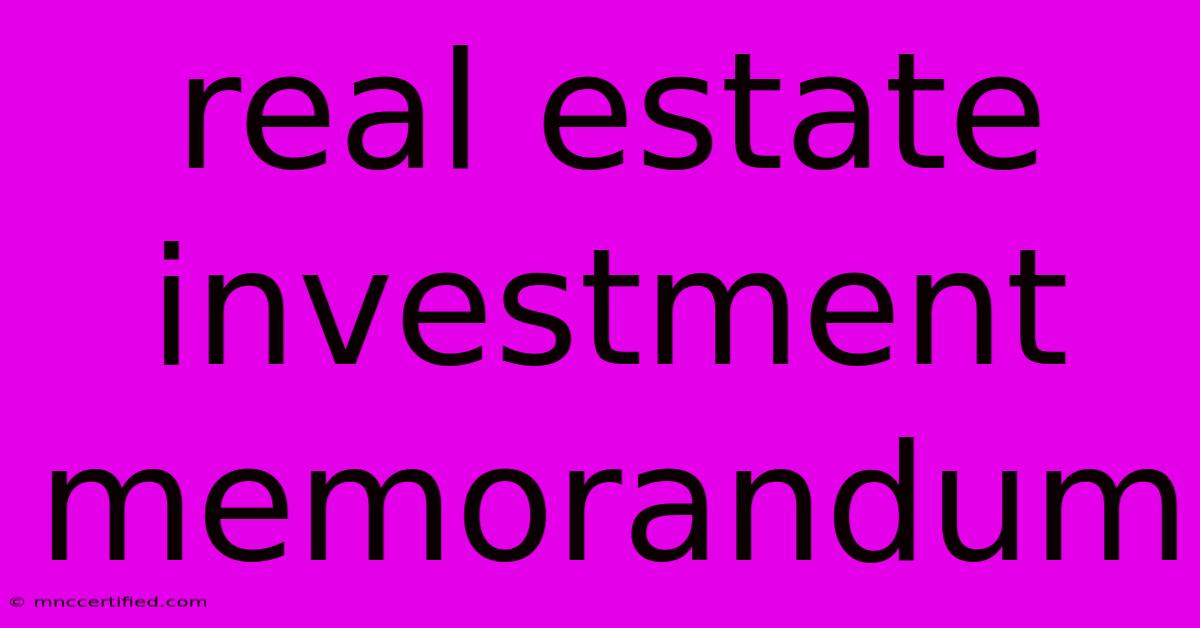Real Estate Investment Memorandum

Table of Contents
Real Estate Investment Memorandum: Your Essential Guide
Investing in real estate can be incredibly lucrative, but it's also complex and risky. Before diving into any deal, a well-structured Real Estate Investment Memorandum (REIM) is crucial. This document serves as a comprehensive overview of the investment opportunity, outlining key details, risks, and potential returns for potential investors. This guide will walk you through the essential components of a compelling REIM, helping you navigate the process and attract the right investors.
What is a Real Estate Investment Memorandum?
A Real Estate Investment Memorandum, often shortened to REIM, is a formal document used to present a real estate investment opportunity to potential investors. Think of it as a detailed business plan specifically for a real estate project. It's not just a sales pitch; it's a thorough analysis designed to provide potential investors with all the information they need to make an informed decision. A well-crafted REIM can significantly increase your chances of securing funding.
Key Differences Between a REIM and a Business Plan
While both a REIM and a business plan outline a project's details, they differ in focus and audience. A business plan is broader, covering all aspects of a company's operations. A REIM, however, is laser-focused on a specific real estate investment, presenting only the information relevant to potential investors in that particular project. This makes it more concise and targeted.
Essential Components of a Winning REIM
A high-quality REIM needs to be both informative and persuasive. Here's a breakdown of the key sections:
1. Executive Summary
This is your elevator pitch. It provides a concise overview of the entire investment opportunity, highlighting key details like the property, investment strategy, projected returns, and risks. Think of it as a compelling summary that grabs the reader's attention and makes them want to learn more.
2. Property Description
This section provides detailed information about the subject property. Include:
- Location: Address, neighborhood characteristics, proximity to amenities, and market analysis.
- Property Features: Size, age, condition, number of units (if applicable), and any unique features.
- Legal Description: Include the official legal description of the property.
- Photos and Floor Plans: High-quality visuals are essential for showcasing the property's appeal.
3. Market Analysis
A robust market analysis demonstrates your understanding of the local real estate market. This should include:
- Market Trends: Current market conditions, rental rates, occupancy rates, and future projections.
- Comparable Properties: Analysis of similar properties recently sold or currently listed, justifying your valuation.
- Competition: Analysis of competing properties in the area.
4. Investment Strategy
Clearly outline your investment strategy and how you intend to generate returns. This could include:
- Purchase Price and Financing: Details of the proposed purchase price and financing plan.
- Value-Add Strategy: If applicable, detail any planned renovations or improvements to increase property value.
- Exit Strategy: Explain how investors will realize their returns, such as through resale or refinancing.
5. Financial Projections
This is a critical section. Include detailed financial projections, including:
- Pro Forma Statements: Projected income statements, cash flow statements, and balance sheets.
- Return on Investment (ROI): Clearly state the projected ROI for investors.
- Sensitivity Analysis: Analyze the impact of various scenarios (e.g., changes in interest rates, occupancy rates) on the projected returns.
6. Risk Factors
Transparency is key. Identify and discuss potential risks associated with the investment, such as:
- Market Risks: Risks related to changes in market conditions.
- Financial Risks: Risks related to financing and debt.
- Legal and Regulatory Risks: Risks related to zoning, permits, and environmental regulations.
7. Management Team
Highlight the experience and expertise of the management team responsible for executing the investment strategy. This builds investor confidence.
8. Appendix
Include supporting documents, such as appraisals, market research reports, and legal agreements.
Off-Page SEO Strategies for Your REIM
While the above focuses on the on-page SEO of your REIM (content within the document itself), effective off-page SEO is crucial for attracting potential investors. Consider:
- Link Building: Secure backlinks from reputable real estate websites and blogs.
- Social Media Marketing: Promote your REIM on relevant social media platforms.
- Online Directories: List your investment opportunity in relevant online directories.
- Networking: Attend industry events and network with potential investors.
By following these guidelines, you can create a compelling REIM that effectively communicates the investment opportunity and attracts the right investors. Remember, a well-structured and professionally presented REIM is an essential tool for success in real estate investment.

Thank you for visiting our website wich cover about Real Estate Investment Memorandum. We hope the information provided has been useful to you. Feel free to contact us if you have any questions or need further assistance. See you next time and dont miss to bookmark.
Featured Posts
-
Stafford Trading Post Stafford Ny
Nov 20, 2024
-
Punta Cana Real Estate Investment
Nov 20, 2024
-
Trademark Insurance Manchester Tn
Nov 20, 2024
-
Vault Investment Banking Rankings
Nov 20, 2024
-
Fur Trading Family Crossword Clue
Nov 20, 2024